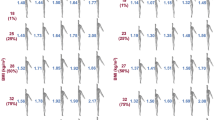Abstract
A first order analytical approximation of steady-state heat conduction in a hollow cylinder exchanging heat at its external surface by convection with a cold and windy environment is presented. The model depicts the thermal behavior of certain body elements, e.g., head/face, when exposed to such environments. The results are presented by dimensionless parameters and facilitate the estimation of wind chill equivalent temperatures (WCETs). The effects of several variables on determining WCETs were studied using specific examples, leading to the following generalizations: (1) the conditions assumed for "calm" wind speed appear to be a dominant factor in determining WCET; (2) the effects, on both (skin) surface temperature and on WCET, of a 1°C change in environmental temperature appear to be more pronounced than those of a 1 m/s change in wind speed; (3) similarly, predicted WCETs are more sensitive to the geometrical dimensions assumed for the modeled entity than they are to wind speeds; and (4) tissue thermal conductivity, the angle at which the convective heat transfer coefficient is measured relative to wind direction, and the factor used to establish "effective" wind speeds in the domain occupied by humans relative to reported values, all seem to have relatively small effects on the determination of WCET. These conclusions strongly suggest, among other things, that for any given combination of environmental conditions, wind chill indices may best be presented as ranges rather than as single values. This seems to apply even when worst-case scenarios are considered. Also emphasized is the need for careful and realistic selection of all the parameter values used in the determination of WCETs.






Similar content being viewed by others
References
ASHRAE (American Society of Heating, Refrigerating and Air Conditioning Engineers) (1997) Handbook fundamentals volume, chap 8. In: Parsons RA (ed) Thermal comfort. ASHRAE, Atlanta, pp 8.1–8.28
Bluestein M (1998) An evaluation of the wind chill factor: its development and applicability. ASME Biomech Eng 120:255–258
Bluestein M, Osczevski R (2002) The basis for the new wind chill temperature chart. In: Conference Proceedings on Biometeorology and Aerobiology. Kansas City, KA, pp 168–171
Bluestein M, Zecher J (1999) A new approach to an accurate wind chill factor. Bull Am Meteorol Soc 80:1893–1899
Brauner N, Shacham M (1995) Meaningful wind chill indicators derived from heat transfer principles. Int J Biometeorol 39:46–52
Chato JC (1985) Selected thermophysical properties of biological materials. In: Shitzer A, Eberhart RC (eds) Heat transfer in medicine and biology: analysis and applications, vol 2. Plenum, New York, pp 413–418
Environment Canada (2001) Canada’s new wind chill index http://www.mb.ec.gc.ca/dir/wintersevere/windchill.en.html
Hill L (1923) The Kata-thermometer in studies of body heat efficiency. Med Res Counc GB Spec Rep Ser 73 London
Kessler E (1993) Wind chill errors. Bull Am Meteorol Soc 74:1743–1744
Kreith F (1973) Principles of heat transfer, 3rd edn. Harper and Row, New York
Molnar GW (1958) An evaluation of wind chill. In: Horvath SM (ed) Cold injury. Proceedings of the 6th Conference. United States Army Med Res Lab, Fort Knox, KY. Capital City Press, Montpelier, VT, pp 175–221
Osczevski RJ (1995a) Comments on "wind chill errors", part II. Bull Am Meteorol Soc 76:1630–1631
Osczevski RJ (1995b) The basis of wind chill. Arctic 48:372–382
Osczevski RJ (2000) Windward cooling: an overlooked factor in the calculation of wind chill. Bull Am Meteorol Soc 81:2975–2978
Osczevski RJ, Bluestein M (2005) The new wind chill equivalent temperature chart. Bull Am Meteorol Soc 86:1453–1458
Shitzer A (2005) Wind chill equivalent temperatures—regarding the impact due to the variability of the environmental convective heat transfer coefficient. Int J Biometeor (in press)
Siple P, Passel CF (1945) Measurements of dry atmospheric cooling in subfreezing temperatures. Proc Am Phil Soc 89:177–199
Steadman R (1971) Indices of windchill of clothed persons. J Appl Meteorol 10:674–683
Tikuisis P (2004) Finger cooling during cold air exposure. Bull Am Meteorol Soc 85:717–723
Tikuisis P, Osczevski RJ (2002) Dynamic model of facial cooling. J Appl Meteorol 12:1241–1246
Tikuisis P, Osczevski RJ (2003) Facial cooling during cold air exposure. Bull Am Meteorol Soc 84:927–933
United States National Weather Service (2001) Wind chill temperature index. http://www.nws.noaa.gov/om/windchill/index.shtml
Winslow CEA, Herrington LP, Gagge AP (1936) A new method of partitional calorimetry. Am J Physiol 116:641–655
Acknowledgements
Thanks are due to my colleague, Prof. Richard de Dear, MacQuarie University, Sydney, Australia, for his valuable comments and discussions. This study was supported in part by the James H. Belfer Chair in Mechanical Engineering at the Technion, Israel Institute of Technology.
Author information
Authors and Affiliations
Corresponding author
Rights and permissions
About this article
Cite this article
Shitzer, A. A parametric study of wind chill equivalent temperatures by a dimensionless steady-state analysis. Int J Biometeorol 50, 215–223 (2006). https://doi.org/10.1007/s00484-005-0012-9
Received:
Revised:
Accepted:
Published:
Issue Date:
DOI: https://doi.org/10.1007/s00484-005-0012-9




